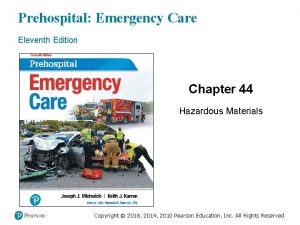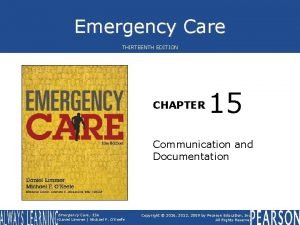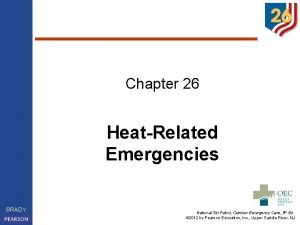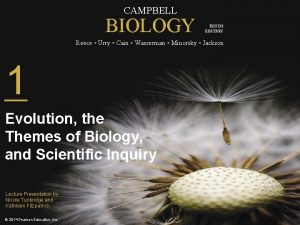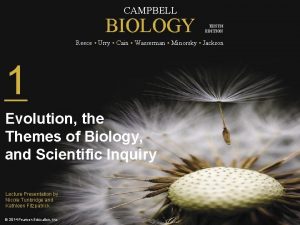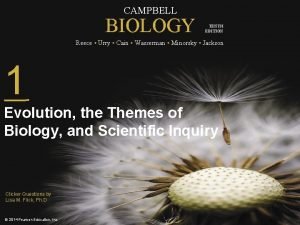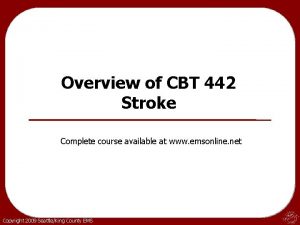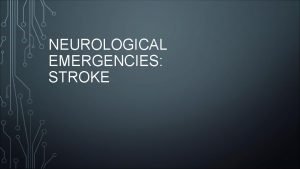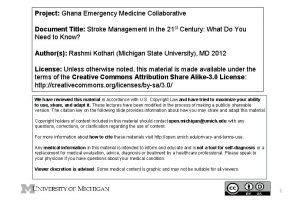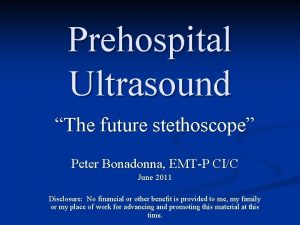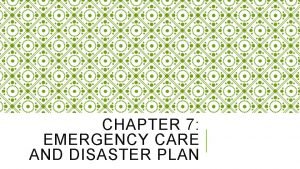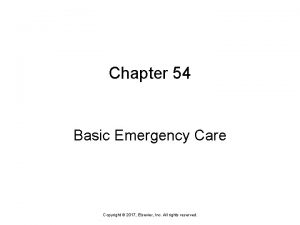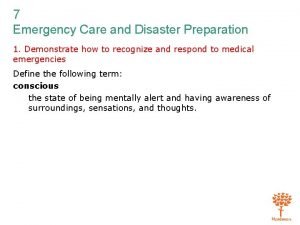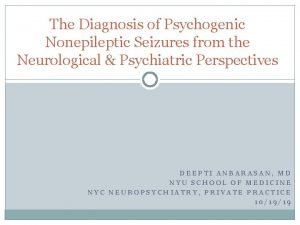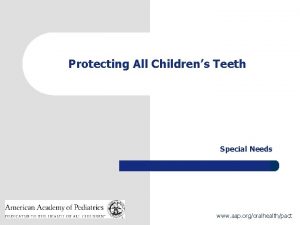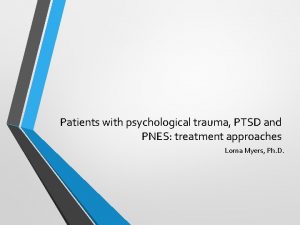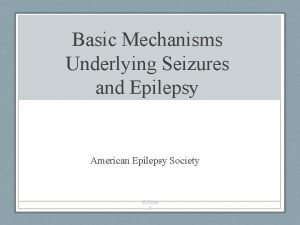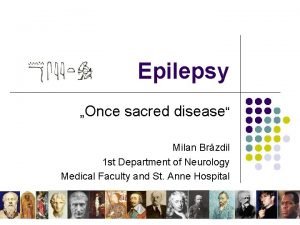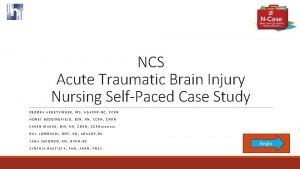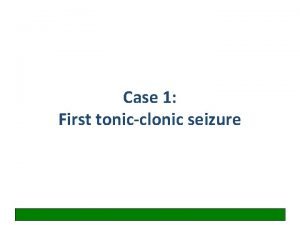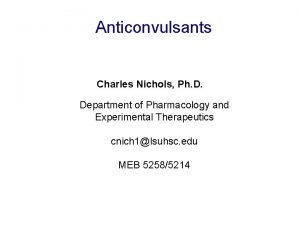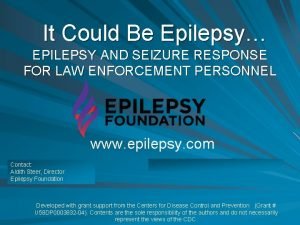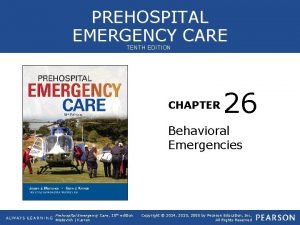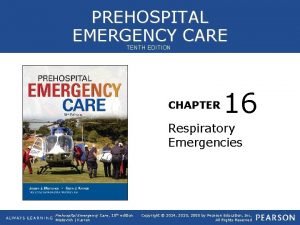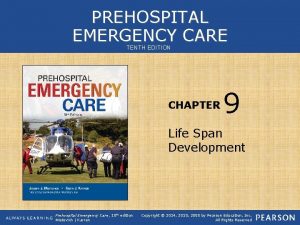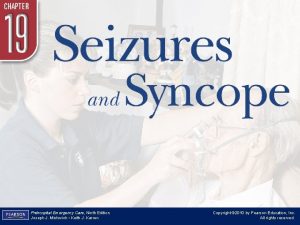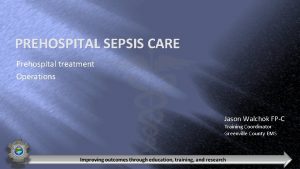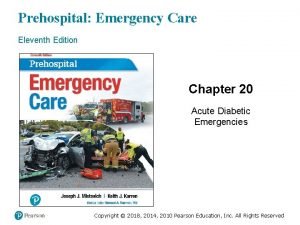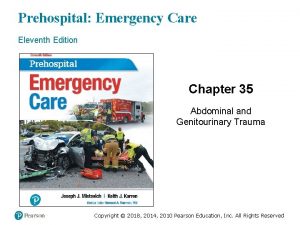PREHOSPITAL EMERGENCY CARE TENTH EDITION CHAPTER 19 Seizures















































- Slides: 47

PREHOSPITAL EMERGENCY CARE TENTH EDITION CHAPTER 19 Seizures and Syncope Prehospital Emergency Care, 10 th edition Mistovich | Karren Copyright © 2014, 2010, 2008 by Pearson Education, Inc. All Rights Reserved

Setting the Stage • Overview of Lesson Topics § Seizures § Syncope Prehospital Emergency Care, 10 th edition Mistovich | Karren Copyright © 2014, 2010, 2008 by Pearson Education, Inc. All Rights Reserved

Case Study Introduction EMTs Ana Salinas and Loren Dyer enter a residence for a report of a seizure to find a man in his early 30 s who appears unresponsive, and who has increased respirations with copious oral secretions. They can see that the patient was incontinent of urine. The patient's brother reports that the patient was playing a game of cards when he experienced a seizure, falling out of his chair. Prehospital Emergency Care, 10 th edition Mistovich | Karren Copyright © 2014, 2010, 2008 by Pearson Education, Inc. All Rights Reserved

Case Study • What are the first priorities in the assessment and care of this patient? • What additional information do the EMTs need about the seizure and the patient's history? • Does this patient require transport to the hospital? Prehospital Emergency Care, 10 th edition Mistovich | Karren Copyright © 2014, 2010, 2008 by Pearson Education, Inc. All Rights Reserved

Introduction • EMTs must know the emergency care for patients with seizures and syncope. • A seizure is a sudden onset of abnormal electrical impulses in the brain. • Syncope is a temporary loss of responsiveness. Prehospital Emergency Care, 10 th edition Mistovich | Karren Copyright © 2014, 2010, 2008 by Pearson Education, Inc. All Rights Reserved

Seizures • A seizure is a sudden and temporary alteration in brain function caused by electrical discharges in a group of nerve cells in the brain. • There typically are changes in mental activity and behavior. continued on next slide Prehospital Emergency Care, 10 th edition Mistovich | Karren Copyright © 2014, 2010, 2008 by Pearson Education, Inc. All Rights Reserved

Seizures • A common cause of seizures is epilepsy. • A seizure in a patient without a history of seizures should be suspected of being caused by trauma or a medical problem. continued on next slide Prehospital Emergency Care, 10 th edition Mistovich | Karren Copyright © 2014, 2010, 2008 by Pearson Education, Inc. All Rights Reserved

Seizures • Primary seizures occur from a genetic or unknown cause. § Generalized seizures involve both hemispheres of the brain, which results in loss of consciousness. § Partial seizures involve one hemisphere. • In simple partial seizures, consciousness is retained • In complex partial seizures, mental status is altered continued on next slide Prehospital Emergency Care, 10 th edition Mistovich | Karren Copyright © 2014, 2010, 2008 by Pearson Education, Inc. All Rights Reserved

Seizures • Secondary seizures occur from an underlying cause. • There are several causes, and the seizures are usually generalized. continued on next slide Prehospital Emergency Care, 10 th edition Mistovich | Karren Copyright © 2014, 2010, 2008 by Pearson Education, Inc. All Rights Reserved

Table 19 -1 Common Causes of Secondary Seizures continued on next slide Prehospital Emergency Care, 10 th edition Mistovich | Karren Copyright © 2014, 2010, 2008 by Pearson Education, Inc. All Rights Reserved

Seizures • Status epilepticus § Generalized motor seizures that last more than 5 minutes or seizures that occur consecutively without a period of responsiveness between them § Life-threatening emergency continued on next slide Prehospital Emergency Care, 10 th edition Mistovich | Karren Copyright © 2014, 2010, 2008 by Pearson Education, Inc. All Rights Reserved

Seizures • Generalized tonic-clonic seizure § Involves the cerebral hemispheres and reticular activating system § Consist of six stages: continued on next slide Prehospital Emergency Care, 10 th edition Mistovich | Karren Copyright © 2014, 2010, 2008 by Pearson Education, Inc. All Rights Reserved

Seizures • Generalized tonic-clonic seizure § § § Aura Loss of consciousness Tonic phase (muscle rigidity) Hypertonic phase Clonic phase (convulsion) Postictal state continued on next slide Prehospital Emergency Care, 10 th edition Mistovich | Karren Copyright © 2014, 2010, 2008 by Pearson Education, Inc. All Rights Reserved

A generalized tonic-clonic, or grand mal, seizure is a sign of abnormal release of electrical impulses in the brain: (a) aura, (b) loss of consciousness followed by tonic phase, (c) clonic phase, (d) postictal phase. continued on next slide Prehospital Emergency Care, 10 th edition Mistovich | Karren Copyright © 2014, 2010, 2008 by Pearson Education, Inc. All Rights Reserved

Seizures • Generalized tonic-clonic seizure emergency medical care § If the seizure has stopped, provide reassurance and conduct an assessment. § Follow protocol if the patient refuses treatment. § Status epilepticus is a life-threatening emergency. continued on next slide Prehospital Emergency Care, 10 th edition Mistovich | Karren Copyright © 2014, 2010, 2008 by Pearson Education, Inc. All Rights Reserved

Seizures • Simple partial seizure § Involves abnormal movements of one area of the body § The patient is awake and aware. § The seizure may spread and generalize. continued on next slide Prehospital Emergency Care, 10 th edition Mistovich | Karren Copyright © 2014, 2010, 2008 by Pearson Education, Inc. All Rights Reserved

Seizures • Complex partial seizure § The patient remains awake, but is not aware. § Starts with a blank stare followed by random movements, such as chewing or lip smacking § May repeat words or phrases § Does not respond to commands continued on next slide Prehospital Emergency Care, 10 th edition Mistovich | Karren Copyright © 2014, 2010, 2008 by Pearson Education, Inc. All Rights Reserved

Seizures • Absence seizure § § Most common in children Characterized by a blank stare There may be rapid blinking or chewing. Patient quickly returns to awareness. continued on next slide Prehospital Emergency Care, 10 th edition Mistovich | Karren Copyright © 2014, 2010, 2008 by Pearson Education, Inc. All Rights Reserved

Seizures • Febrile seizures § Caused by fever § Most common from ages 6 months to 6 years Prehospital Emergency Care, 10 th edition Mistovich | Karren Copyright © 2014, 2010, 2008 by Pearson Education, Inc. All Rights Reserved

Seizures • Assessment-based approach § Scene size-up • Look for evidence of trauma, poisoning, or medical conditions. • The patient may be postictal. • If the patient is actively seizing, move objects away from him. continued on next slide Prehospital Emergency Care, 10 th edition Mistovich | Karren Copyright © 2014, 2010, 2008 by Pearson Education, Inc. All Rights Reserved

Protect the seizing patient from injury by moving furniture and objects away. continued on next slide Prehospital Emergency Care, 10 th edition Mistovich | Karren Copyright © 2014, 2010, 2008 by Pearson Education, Inc. All Rights Reserved

Seizures • Assessment-based approach § Primary assessment • Assess the airway; unresponsive and seizing patients are at risk for airway compromise. • Assess breathing and oxygenation. • Assess circulation. continued on next slide Prehospital Emergency Care, 10 th edition Mistovich | Karren Copyright © 2014, 2010, 2008 by Pearson Education, Inc. All Rights Reserved

Seizures • Assessment-based approach § Primary assessment • Be prepared to suction. • Avoid an oropharyngeal airway. • If the patient is severely cyanotic or the seizure has lasted more than 5 minutes, begin positive pressure ventilation. • Begin CPR and apply the AED if the patient is pulseless. continued on next slide Prehospital Emergency Care, 10 th edition Mistovich | Karren Copyright © 2014, 2010, 2008 by Pearson Education, Inc. All Rights Reserved

Clear the airway of secretions, blood, and vomitus. continued on next slide Prehospital Emergency Care, 10 th edition Mistovich | Karren Copyright © 2014, 2010, 2008 by Pearson Education, Inc. All Rights Reserved

Seizures • Conditions that indicate high-priority transport § The patient remains unresponsive. § Airway, breathing, or circulation is inadequate. § A second generalized motor seizure occurs without a period of responsiveness between the seizure episodes (status epilepticus). continued on next slide Prehospital Emergency Care, 10 th edition Mistovich | Karren Copyright © 2014, 2010, 2008 by Pearson Education, Inc. All Rights Reserved

Seizures • Conditions that indicate high priority transport § A generalized motor seizure lasts longer than 5 minutes (status epilepticus). § The patient is pregnant, has a history of diabetes, or is injured. § The seizure has occurred in water, such as a swimming pool or lake. continued on next slide Prehospital Emergency Care, 10 th edition Mistovich | Karren Copyright © 2014, 2010, 2008 by Pearson Education, Inc. All Rights Reserved

Seizures • Conditions that indicate high priority transport § There is evidence of head trauma leading to the seizure. § There is no history of epilepsy or other seizure disorder. § The seizure is the result of drug or alcohol withdrawal. continued on next slide Prehospital Emergency Care, 10 th edition Mistovich | Karren Copyright © 2014, 2010, 2008 by Pearson Education, Inc. All Rights Reserved

Seizures • Secondary assessment § Assess the head for signs of trauma. § There may be weakness or paralysis on one side. § Assess the extremities for signs of trauma. continued on next slide Prehospital Emergency Care, 10 th edition Mistovich | Karren Copyright © 2014, 2010, 2008 by Pearson Education, Inc. All Rights Reserved

Seizures • Secondary assessment § Assess vital signs. § Apply oxygen if the Sp. O 2 is <94%. § Assess the blood glucose level. continued on next slide Prehospital Emergency Care, 10 th edition Mistovich | Karren Copyright © 2014, 2010, 2008 by Pearson Education, Inc. All Rights Reserved

Seizures • Secondary assessment § Consider the need for ALS. § Obtain a history, including medications. continued on next slide Prehospital Emergency Care, 10 th edition Mistovich | Karren Copyright © 2014, 2010, 2008 by Pearson Education, Inc. All Rights Reserved

Seizures • Obtain a description of the seizure activity, including what it looked like and how long it lasted. • Determine whether the patient fell or hit his head. • Ask about recent illness or head trauma. continued on next slide Prehospital Emergency Care, 10 th edition Mistovich | Karren Copyright © 2014, 2010, 2008 by Pearson Education, Inc. All Rights Reserved

Seizures • If the patient takes medications for seizures, ask if he has been taking it. • Determine whethere is a history of seizures. continued on next slide Prehospital Emergency Care, 10 th edition Mistovich | Karren Copyright © 2014, 2010, 2008 by Pearson Education, Inc. All Rights Reserved

Table 19 -2 Medications Commonly Used in the Treatment of Epilepsy continued on next slide Prehospital Emergency Care, 10 th edition Mistovich | Karren Copyright © 2014, 2010, 2008 by Pearson Education, Inc. All Rights Reserved

Seizures • Signs and symptoms may include: § § Convulsions Rigid muscle contractions or spasms Biting the tongue Excessive saliva continued on next slide Prehospital Emergency Care, 10 th edition Mistovich | Karren Copyright © 2014, 2010, 2008 by Pearson Education, Inc. All Rights Reserved

Seizures • Signs and symptoms may include: § § Urinary or bowel incontinence Repetitive activity Localized muscle twitching Visual or olfactory hallucinations continued on next slide Prehospital Emergency Care, 10 th edition Mistovich | Karren Copyright © 2014, 2010, 2008 by Pearson Education, Inc. All Rights Reserved

Seizures • Emergency medical care § Position the patient. • Lateral recumbent for postictal patients • Consider the need for spinal stabilization. § Maintain a patient airway. • A nasopharyngeal airway, if needed, is preferred. • Do not force anything between the teeth. continued on next slide Prehospital Emergency Care, 10 th edition Mistovich | Karren Copyright © 2014, 2010, 2008 by Pearson Education, Inc. All Rights Reserved

Seizures • Emergency medical care § Use suction as needed. § Begin positive pressure ventilation, if needed. § Protect the patient from injury. continued on next slide Prehospital Emergency Care, 10 th edition Mistovich | Karren Copyright © 2014, 2010, 2008 by Pearson Education, Inc. All Rights Reserved

Seizures • Emergency medical care § Maintain adequate oxygenation. § Transport § Reassess Prehospital Emergency Care, 10 th edition Mistovich | Karren Copyright © 2014, 2010, 2008 by Pearson Education, Inc. All Rights Reserved

Syncope • Sudden, temporary loss of consciousness • Occurs from interruption of cerebral perfusion • A common cause is increased parasympathetic influence. • Bystanders may mistake syncope for a seizure. continued on next slide Prehospital Emergency Care, 10 th edition Mistovich | Karren Copyright © 2014, 2010, 2008 by Pearson Education, Inc. All Rights Reserved

Table 19 -3 Syncope Differentiation Between Seizures and continued on next slide Prehospital Emergency Care, 10 th edition Mistovich | Karren Copyright © 2014, 2010, 2008 by Pearson Education, Inc. All Rights Reserved

Syncope • Conduct primary and secondary assessments. • Keep the patient supine. • Consider serious underlying causes and encourage transport. Prehospital Emergency Care, 10 th edition Mistovich | Karren Copyright © 2014, 2010, 2008 by Pearson Education, Inc. All Rights Reserved

Assess the head for any sign of trauma. Prehospital Emergency Care, 10 th edition Mistovich | Karren Copyright © 2014, 2010, 2008 by Pearson Education, Inc. All Rights Reserved

Case Study Conclusion Ana and Loren turn the patient, Dan, onto his left side and Ana suctions his airway. Dan is responsive to painful stimuli, and has adequate breathing. His skin is warm and moist, and there is no cyanosis. His Sp. O 2 is 99%. The seizure lasted about two minutes. Its description is consistent with a tonic-clonic seizure, and looked like other seizures Dan has had. continued on next slide Prehospital Emergency Care, 10 th edition Mistovich | Karren Copyright © 2014, 2010, 2008 by Pearson Education, Inc. All Rights Reserved

Case Study Conclusion There is no evidence of injury to the head, trunk, or extremities, though it does appear that Dan may have bitten his tongue. Dan has a history of seizures, for which he takes the medication carbamazepine. A quick check of the prescription bottle shows that Dan may have missed several doses since the prescription was filled two weeks ago. continued on next slide Prehospital Emergency Care, 10 th edition Mistovich | Karren Copyright © 2014, 2010, 2008 by Pearson Education, Inc. All Rights Reserved

Case Study Conclusion Dan has become responsive to verbal stimuli, but because his mental status remains altered and he has not been compliant with his medications, Ana and Loren recognize that he should be transported. En route to the hospital, Dan becomes more responsive, but remains sleepy. The EMTs turn his care over to the ED staff with a complete report. Prehospital Emergency Care, 10 th edition Mistovich | Karren Copyright © 2014, 2010, 2008 by Pearson Education, Inc. All Rights Reserved

Lesson Summary • Seizures result from abnormal electrical impulses in the brain, which can manifest in a variety of ways. • Seizures may be generalized or partial. • Status epilepticus is a life-threatening emergency. continued on next slide Prehospital Emergency Care, 10 th edition Mistovich | Karren Copyright © 2014, 2010, 2008 by Pearson Education, Inc. All Rights Reserved

Lesson Summary • Syncope results from a temporary interruption in brain perfusion. • Syncope may be benign, but can have serious underlying causes. Prehospital Emergency Care, 10 th edition Mistovich | Karren Copyright © 2014, 2010, 2008 by Pearson Education, Inc. All Rights Reserved
 Prehospital emergency care 11th edition chapter 1
Prehospital emergency care 11th edition chapter 1 Prehospital emergency care 10th edition
Prehospital emergency care 10th edition Therapeutic communication techniques
Therapeutic communication techniques Prehospital emergency care 11th edition
Prehospital emergency care 11th edition Prehospital emergency care 11th edition
Prehospital emergency care 11th edition Prehospital emergency care 11th edition
Prehospital emergency care 11th edition Emergency care 13th edition
Emergency care 13th edition Outdoor emergency care 6th edition
Outdoor emergency care 6th edition Campbell biology tenth edition
Campbell biology tenth edition Campbell biology tenth edition
Campbell biology tenth edition Campbell biology tenth edition
Campbell biology tenth edition Elementary statistics tenth edition
Elementary statistics tenth edition Floyd digital fundamentals
Floyd digital fundamentals Corporate finance tenth edition
Corporate finance tenth edition Psychology tenth edition david g myers
Psychology tenth edition david g myers Introduction to genetic analysis tenth edition
Introduction to genetic analysis tenth edition Corporate finance tenth edition
Corporate finance tenth edition Corporate finance tenth edition
Corporate finance tenth edition Corporate finance tenth edition
Corporate finance tenth edition Corporate finance tenth edition
Corporate finance tenth edition Campbell biology tenth edition
Campbell biology tenth edition The graph shows data from the light colored soil enclosure
The graph shows data from the light colored soil enclosure Biology tenth edition
Biology tenth edition Biology tenth edition
Biology tenth edition Cincinatti stroke scale
Cincinatti stroke scale Befast stroke scale
Befast stroke scale Cincinnati prehospital stroke scale
Cincinnati prehospital stroke scale Peter bonadonna
Peter bonadonna Chapter 7 emergency care and disaster preparation
Chapter 7 emergency care and disaster preparation Chapter 54 basic emergency care
Chapter 54 basic emergency care Emergency care first aid and disasters
Emergency care first aid and disasters Chapter 7 emergency care and disaster preparation
Chapter 7 emergency care and disaster preparation Non epileptic seizures
Non epileptic seizures Pediatric seizures
Pediatric seizures Lorna myers pnes
Lorna myers pnes Tremors vs seizures
Tremors vs seizures Basic mechanisms underlying seizures and epilepsy
Basic mechanisms underlying seizures and epilepsy Psychomotor seizures
Psychomotor seizures Psychomotor seizures
Psychomotor seizures Hemorrhagic irregular tissue fragments
Hemorrhagic irregular tissue fragments Nursing management of encephalitis
Nursing management of encephalitis Seizures
Seizures Pimidone
Pimidone Tonic vs clonic
Tonic vs clonic Seizures meaning
Seizures meaning Benign febrile convulsion
Benign febrile convulsion Simple partial seizures vs complex
Simple partial seizures vs complex Simple partial seizures vs complex
Simple partial seizures vs complex





